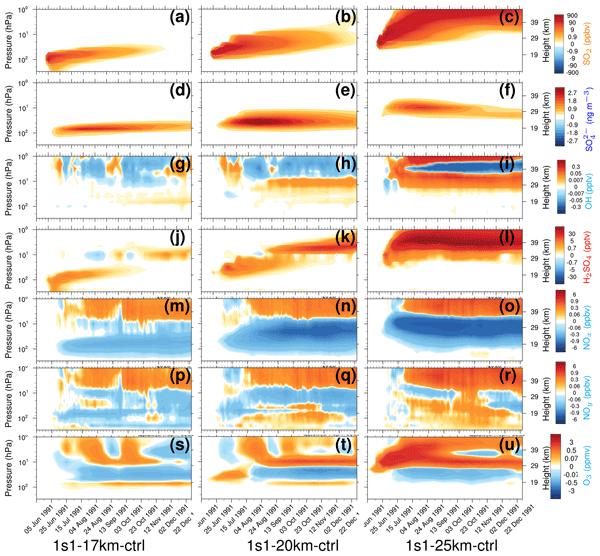Recent publication in Atomspheric Chemistry and Physics

The research article “The effect of ash, water vapor, and heterogeneous chemistry on the evolution of a Pinatubo-size volcanic cloud” by Mohamed Abdelkader et al. has been published in the EGU journal “Atmospheric Chemistry and Physics” as open access. The authors conducted ensemble studies with the ECHAM5/MESSy2 atmospheric chemistry general circulation model (EMAC) on the 1991 Pinatubo volcanic cloud. The experiments include different injection configurations to test the evolution of SO2, SO₄²⁻, ash masses, stratospheric aerosol optical depth, surface area density, and the stratospheric temperature response against available observations.
https://doi.org/10.5194/acp-23-471-2023
Abstract: We employ the ECHAM5/MESSy2 atmospheric chemistry general circulation model (EMAC) that incorporates calculations of gas-phase and heterogeneous chemistry coupled with the ozone cycle and aerosol formation, transport, and microphysics to calculate the 1991 Pinatubo volcanic cloud. We considered simultaneous injections of SO2, volcanic ash, and water vapor. We conducted multiple ensemble simulations with different injection configurations to test the evolution of SO2, SO₄²⁻, ash masses, stratospheric aerosol optical depth, surface area density (SAD), and the stratospheric temperature response against available observations. We found that the volcanic cloud evolution is sensitive to the altitude where volcanic debris is initially injected and the initial concentrations of the eruption products that affect radiative heating and lofting of the volcanic cloud. The numerical experiments with the injection of 12 Mt SO2, 75 Mt of volcanic ash, and 150 Mt of water vapor at 20 km show the best agreement with the observation aerosol optical depth and stratospheric temperature response. Volcanic water injected by eruptive jet and/or intruding through the tropopause accelerates SO2 oxidation. But the mass of volcanic water retained in the stratosphere is controlled by the stratospheric temperature at the injection level. For example, if volcanic materials are released in the cold point above the tropical tropopause, most of the injected water freezes and sediments as ice crystals. The water vapor directly injected into the volcanic cloud increases the SO₄²⁻ mass and stratospheric aerosol optical depth by about 5 %. The coarse ash comprises 98 % of the ash injected mass. It sediments within a few days, but aged submicron ash could stay in the stratosphere for a few months providing SAD for heterogeneous chemistry. The presence of ash accelerates the SO2 oxidation by 10 %–20 % due to heterogeneous chemistry, radiative heating, lofting, and faster dispersion of volcanic debris. Ash aging affects its lifetime and optical properties, almost doubling the ash radiative heating. The 2.5-year simulations show that the stratospheric temperature anomalies forced by radiative heating of volcanic debris in our experiments with the 20 km injection height agree well with observations and reanalysis data. This indicates that the model captures the long-term evolution and climate effect of the Pinatubo volcanic cloud. The volcanic cloud’s initial lofting, facilitated by ash particles’ radiative heating, controls the oxidation rate of SO2. Ash accelerates the formation of the sulfate layer in the first 2 months after the eruption. We also found that the interactive calculations of OH and heterogeneous chemistry increase the volcanic cloud sensitivity to water vapor and ash injections. All those factors must be accounted for in modeling the impact of large-scale volcanic injections on climate and stratospheric chemistry.
© Author(s) 2023. This work is distributed under the Creative Commons Attribution 4.0 License.
Abdelkader, M., Stenchikov, G., Pozzer, A., Tost, H., and Lelieveld, J.: The effect of ash, water vapor, and heterogeneous chemistry on the evolution of a Pinatubo-size volcanic cloud, Atmos. Chem. Phys., 23, 471–500, https://doi.org/10.5194/acp-23-471-2023, 2023.
